1 Meet Apache Airflow
Modern organizations depend on ever-growing volumes of high-quality data, which makes reliable, well-orchestrated pipelines essential. This chapter introduces Apache Airflow as an orchestration platform that coordinates tasks across diverse systems—such as data ingestion, transformation, analytics, and ML—so that teams can produce trustworthy results efficiently. The book takes a practical, production-minded approach, aiming to equip readers to build Airflow pipelines thoughtfully, evaluate when Airflow is a good fit, and take their first steps with confidence.
The chapter first frames data pipelines as directed acyclic graphs (DAGs), where tasks are nodes and dependencies are directed edges. This acyclic structure avoids deadlocks and enables a straightforward execution algorithm that schedules tasks when their upstream dependencies are satisfied. Compared with monolithic scripts, DAGs make dependencies explicit, allow parallel execution of independent branches, and support targeted reruns after failures. Airflow is then positioned within the broader ecosystem of workflow managers, highlighting trade-offs in how workflows are defined (code vs. static files) and which features are built in (scheduling, monitoring, UI), underscoring that tool selection should align with specific requirements.
Airflow’s core strengths include defining pipelines as code (primarily in Python) with dynamic construction, extensive integrations via providers, and robust scheduling for recurring or event-driven runs. Its architecture—DAG Processor, scheduler, workers, triggerer, and API server/metastore—coordinates parsing, scheduling, execution, and observability, while the web UI (graph and grid views) aids monitoring, debugging, retries, and selective reruns. Airflow also excels at incremental processing and backfilling across time intervals. It is a strong choice for batch-oriented, time- or event-triggered workflows, broad system integrations, and teams applying software engineering best practices; it is less suited to real-time streaming, low-code teams, or scenarios demanding built-in lineage/versioning. The chapter closes by outlining the book’s path from fundamentals to advanced patterns and deployment operations.
For this weather dashboard, weather data is fetched from an external API and fed into a dynamic dashboard.

Graph representation of the data pipeline for the weather dashboard. Nodes represent tasks and directed edges represent dependencies between tasks (with an edge pointing from task 1 to task 2, indicating that task 1 needs to be run before task 2).

Cycles in graphs prevent task execution due to circular dependencies. In acyclic graphs (top), there is a clear path to execute the three different tasks. However, in cyclic graphs (bottom), there is no longer a clear execution path due to the interdependency between tasks 2 and 3.
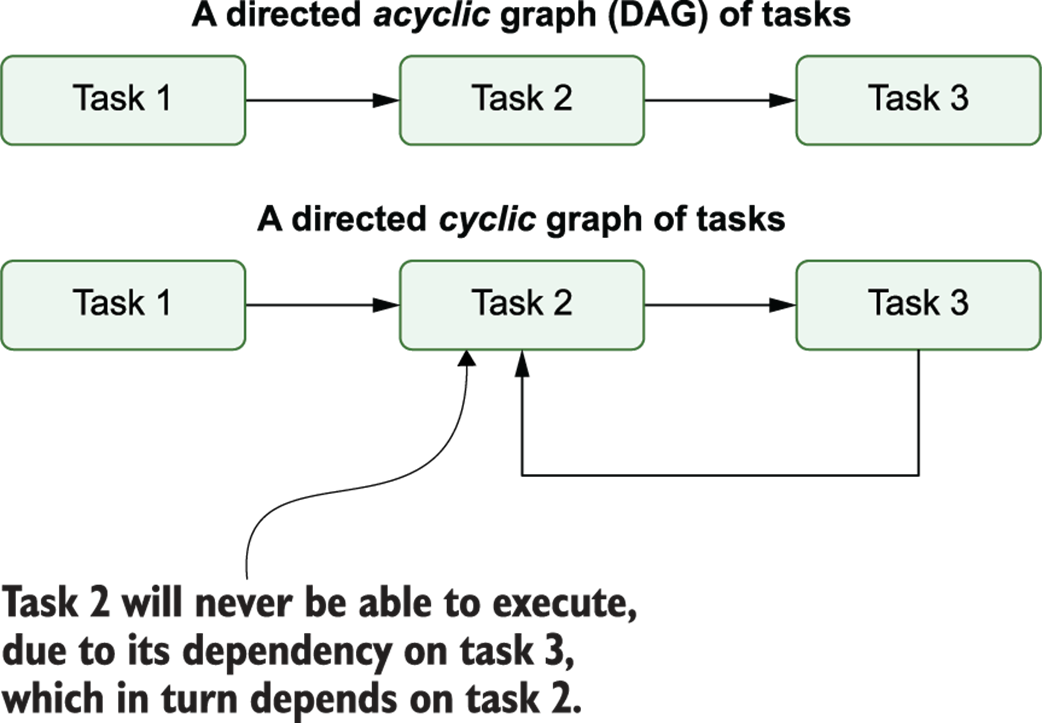
Using the DAG structure to execute tasks in the data pipeline in the correct order: depicts each task’s state during each of the loops through the algorithm, demonstrating how this leads to the completed execution of the pipeline (end state)
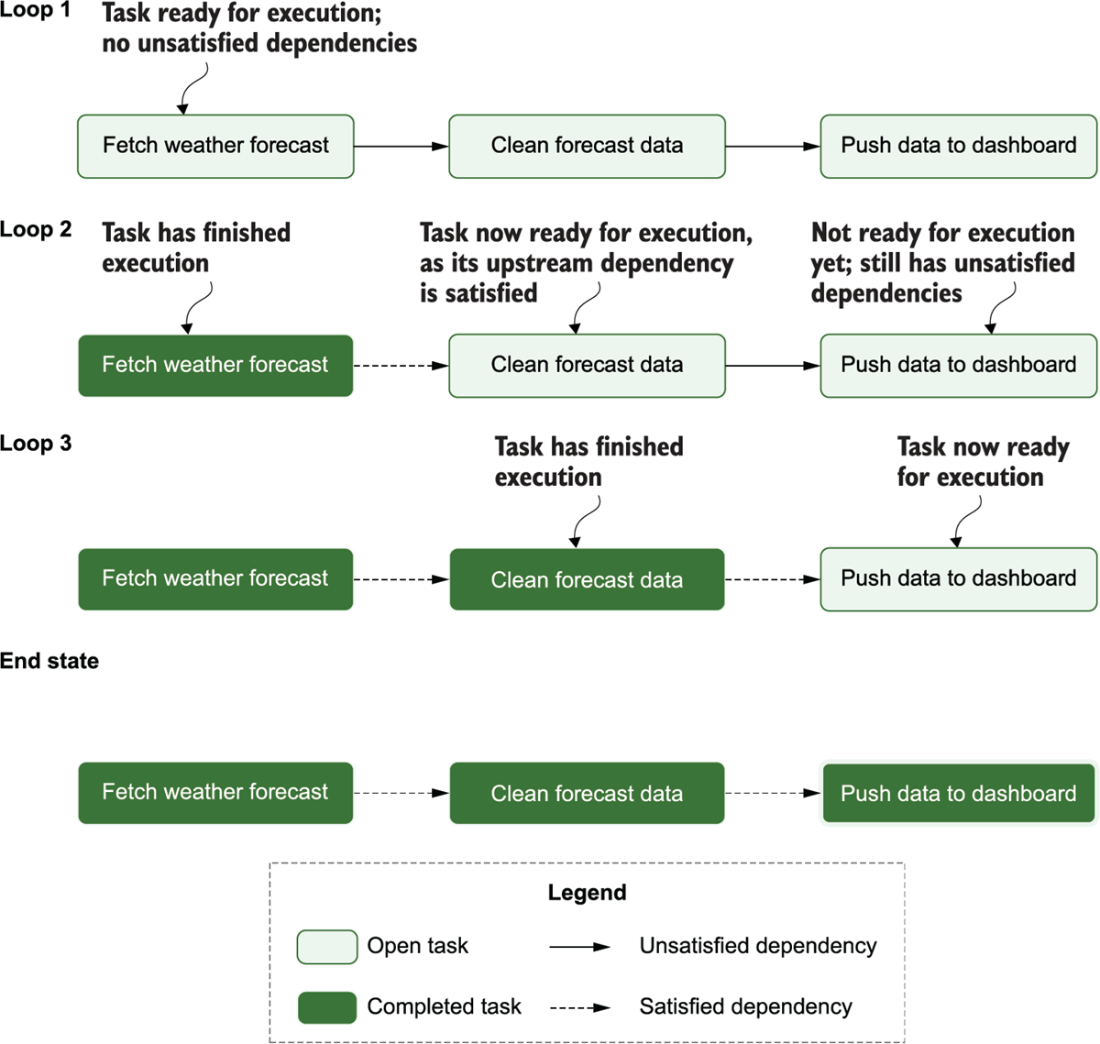
Overview of the umbrella demand use case, in which historical weather and sales data are used to train a model that predicts future sales demands depending on weather forecasts
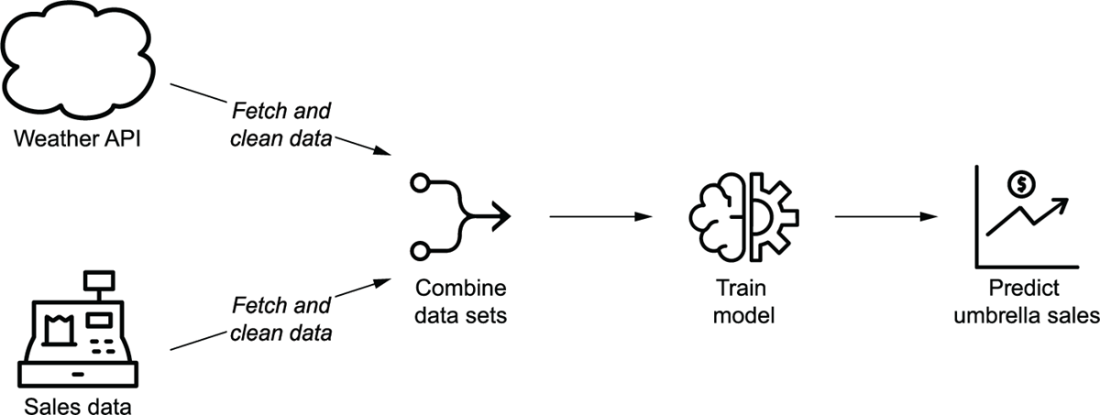
Independence between sales and weather tasks in the graph representation of the data pipeline for the umbrella demand forecast model. The two sets of fetch/cleaning tasks are independent as they involve two different data sets (the weather and sales data sets). This independence is indicated by the lack of edges between the two sets of tasks.

Airflow pipelines are defined as DAGs using Python code in DAG files. Each DAG file typically defines one DAG, which describes the different tasks and their dependencies. Besides this, the DAG also defines a schedule interval that determines when the DAG is executed by Airflow.

The main components involved in Airflow are the Airflow API server, scheduler, DAG processor, triggerer and workers.
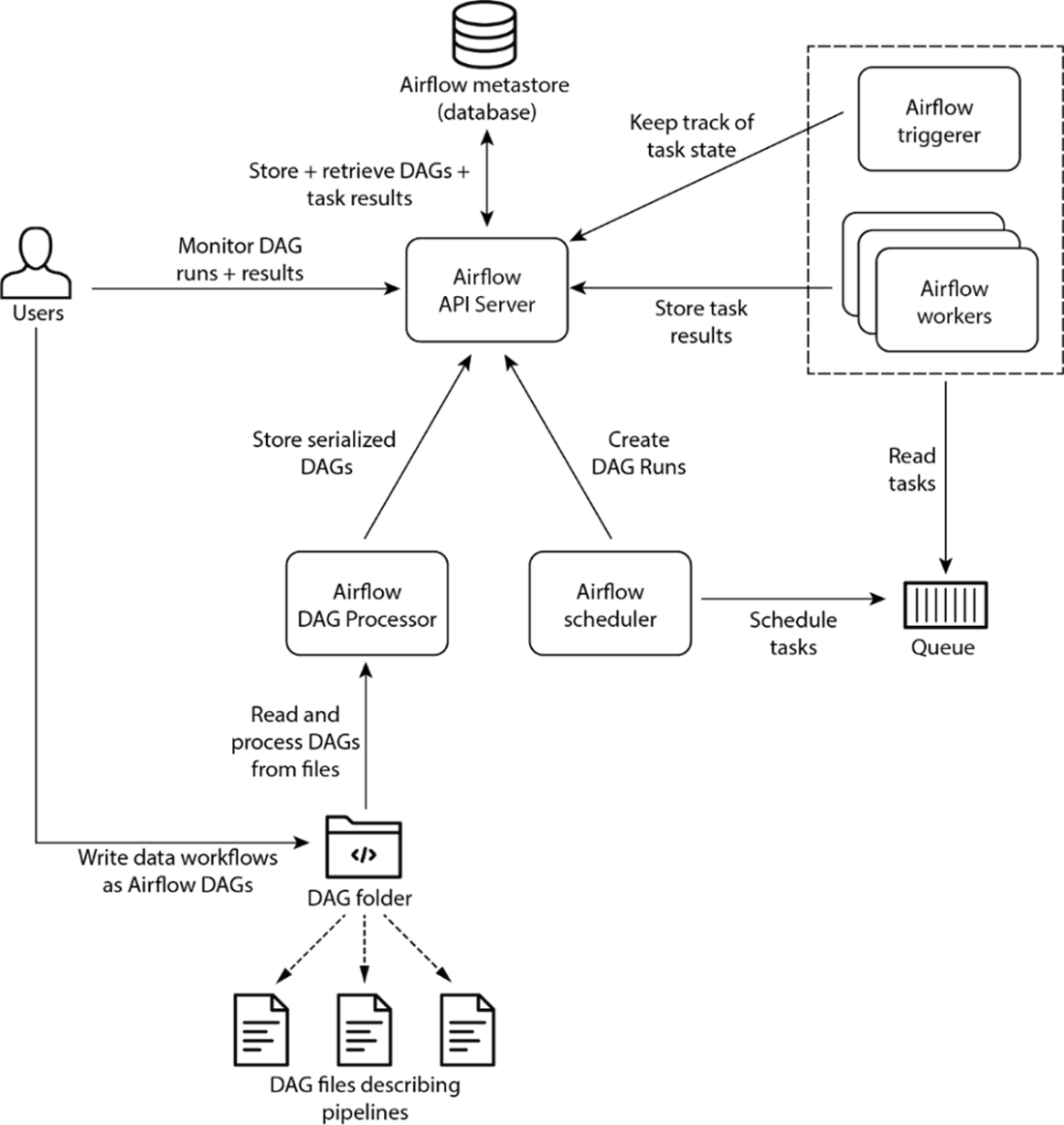
Developing and executing pipelines as DAGs using Airflow. Once the user has written the DAG, the DAG Processor and scheduler ensure that the DAG is run at the right moment. The user can monitor progress and output while the DAG is running at all times.
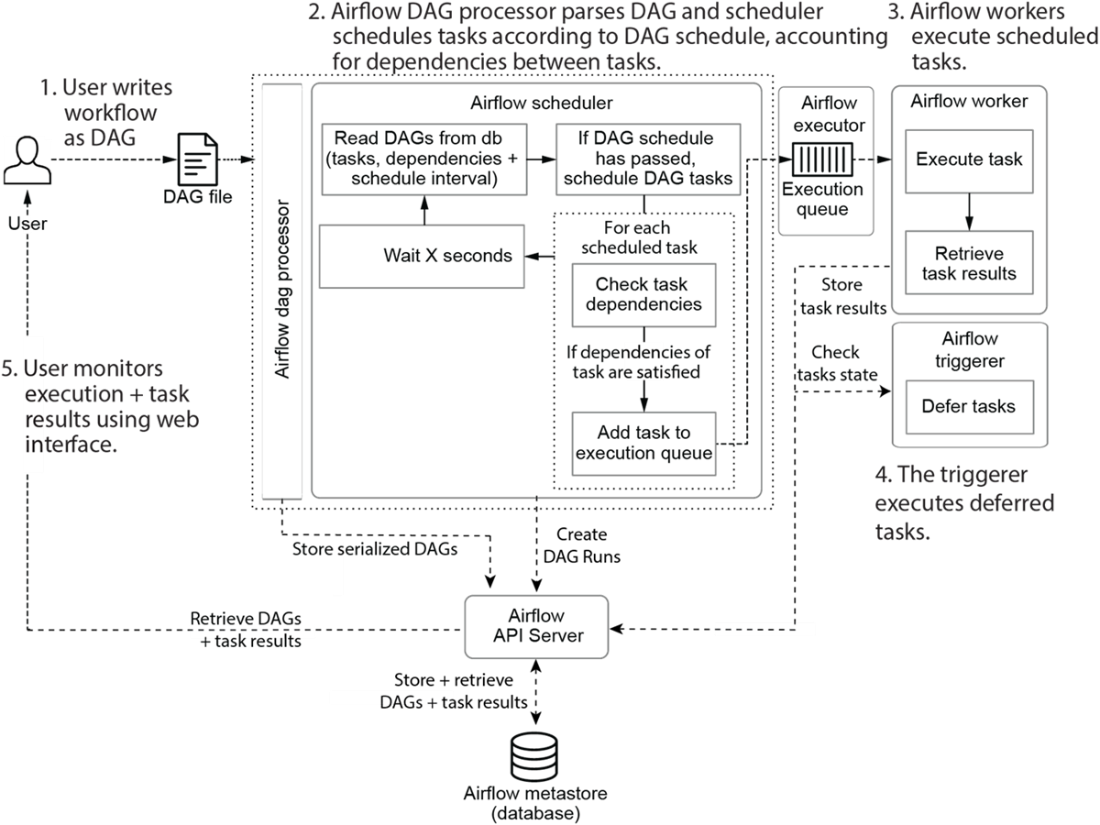
The login page for the Airflow web interface. In the code examples accompanying this book, a default user “airflow” is provided with the password “airflow”.

The main page of Airflow’s web interface, showing a high-level overview of all DAGs and their recent results.

The DAGs page of Airflow’s web interface, showing a high-level overview of all DAGs and their recent results.
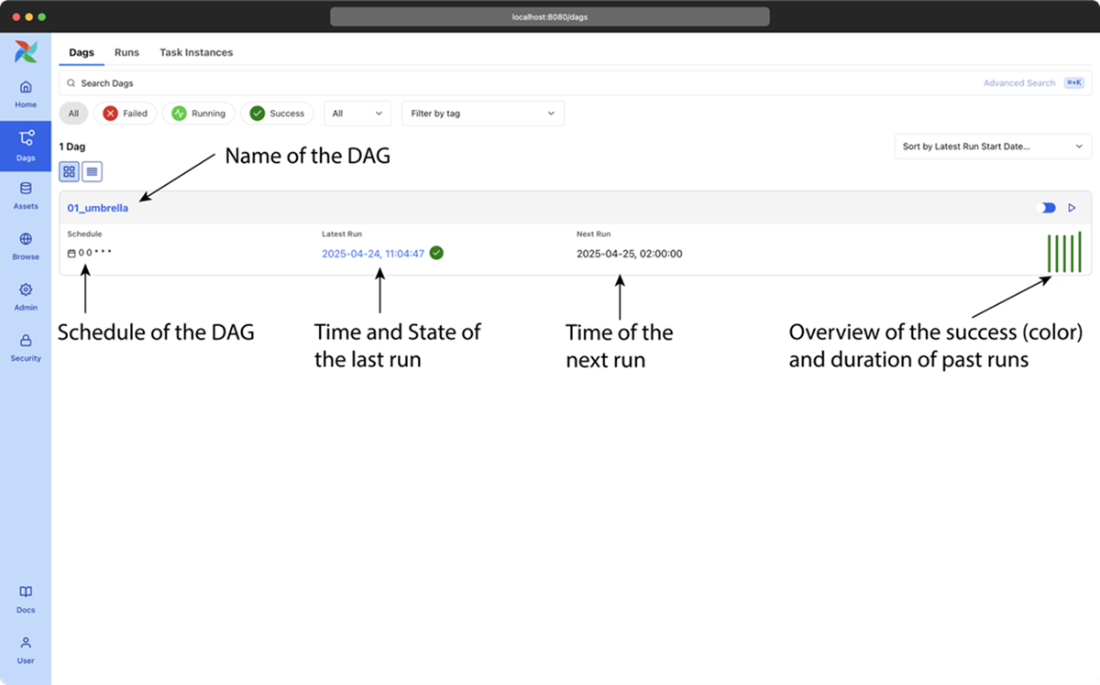
The graph view in Airflow’s web interface, showing an overview of the tasks in an individual DAG and the dependencies between these tasks
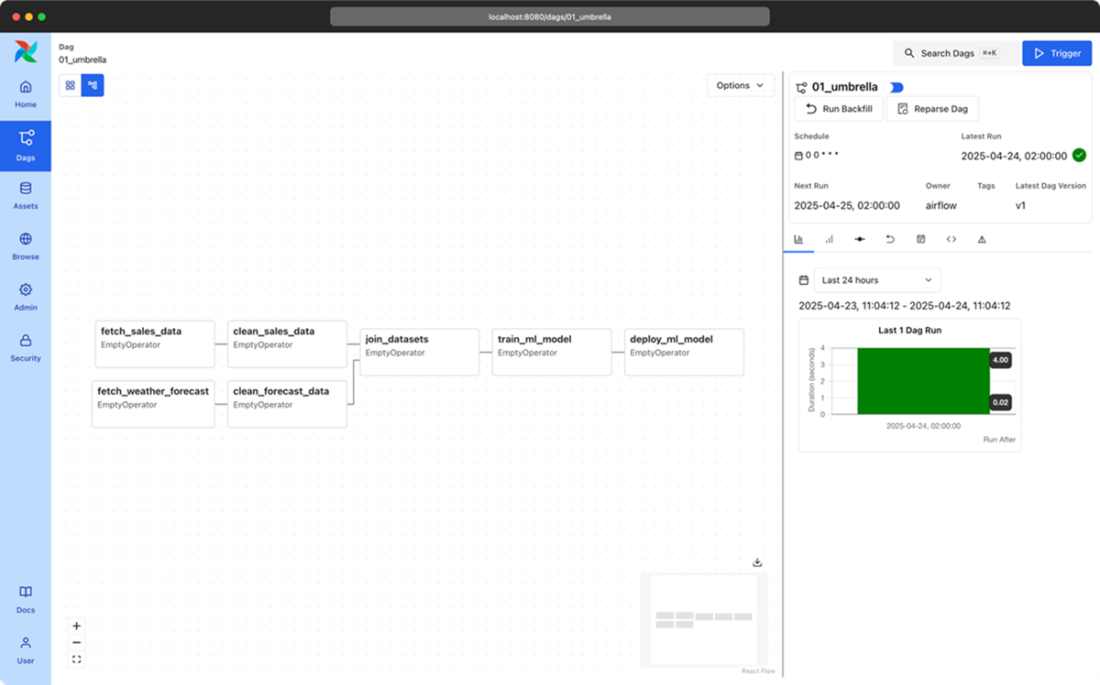
Airflow’s grid view, showing the results of multiple runs of the umbrella sales model DAG (most recent + historical runs). The columns show the status of one execution of the DAG and the rows show the status of all executions of a single task. Colors (which you can see in the e-book version) indicate the result of the corresponding task. Users can also click on the task “squares” for more details about a given task instance, or to manage the state of a task so that it can be rerun by Airflow, if desired.x

Summary
- Directed Acyclic Graphs (DAGs) are a visual tool used to represent data workflows in data processing pipelines. A node in a DAG denote the task to be performed, and edges define the dependencies between them. This is not only visually more understandable but also aids in better representation, easier debugging + rerunning, and making use of parallelism compared to single monolithic scripts.
- In Airflow, DAGs are defined using Python files. Airflow 3.0 introduced the option of using other languages. In this book we will focus on Python. These scripts outline the order of task execution and their interdependencies. Airflow parses these files to construct and understand the DAG's structure, enabling task orchestration and scheduling.
- Although many workflow managers have been developed over the years for executing graphs of tasks, Airflow has several key features that makes it uniquely suited for implementing efficient, batch-oriented data pipelines.
- Airflow excels as a workflow orchestration tool due to its intuitive design, scheduling capabilities, and extensible framework. It provides a rich user interface for monitoring and managing tasks in data processing workflows.
- Airflow is comprised of five key components:
- DAG Processor: Reads and parses the DAGs and stores the resulting serialized version of these DAGs in the Metastore for use by (among others) the scheduler
- Scheduler: Reads the DAGs parsed by the DAG Processor, determines if their schedule intervals have elapsed, and queues their tasks for execution.
- Worker: Execute the tasks assigned to them by the scheduler.
- Triggerer: It handles the execution of deferred tasks, which are waiting for external events or conditions.
- API Server: Among other things, presents a user interface for visualizing and monitoring the DAGs and their execution status. The API Server also acts as the interface between all Airflow components
- Airflow enables the setting of a schedule for each DAG, specifying when the pipeline should be executed. In addition, Airflow’s built-in mechanisms are able to manage task failures, automatically.
- Airflow is well-suited for batch-oriented data pipelines, offering sophisticated scheduling options that enable regular, incremental data processing jobs. On the other hand, Airflow is not the right choice for streaming workloads or for implementing highly dynamic pipelines where DAG structure changes from one day to the other.
FAQ
What is Apache Airflow and what problem does it solve?
Airflow is an open source orchestrator for building, scheduling, and monitoring data pipelines. It represents workflows as directed acyclic graphs (DAGs) of tasks and coordinates work across systems to produce reliable, high‑quality data.What is a DAG in Airflow, and why must it be acyclic?
A DAG is a directed acyclic graph where nodes are tasks and edges represent dependencies. The “acyclic” property prevents circular dependencies that would deadlock execution (for example, task A waiting on task B while B also waits on A).How does Airflow execute a pipeline end to end?
- DAG files are parsed by the DAG Processor and stored in the metastore (via the API server).- The Scheduler checks each DAG’s schedule; when due, it evaluates task dependencies and queues ready tasks.
- Workers pick up queued tasks and run them; results and logs are recorded in the metastore.
- The Triggerer monitors certain async/deferred tasks so workers can focus on runnable work.
- Users observe and manage runs through the API server’s web interface.
 Data Pipelines with Apache Airflow, Second Edition ebook for free
Data Pipelines with Apache Airflow, Second Edition ebook for free